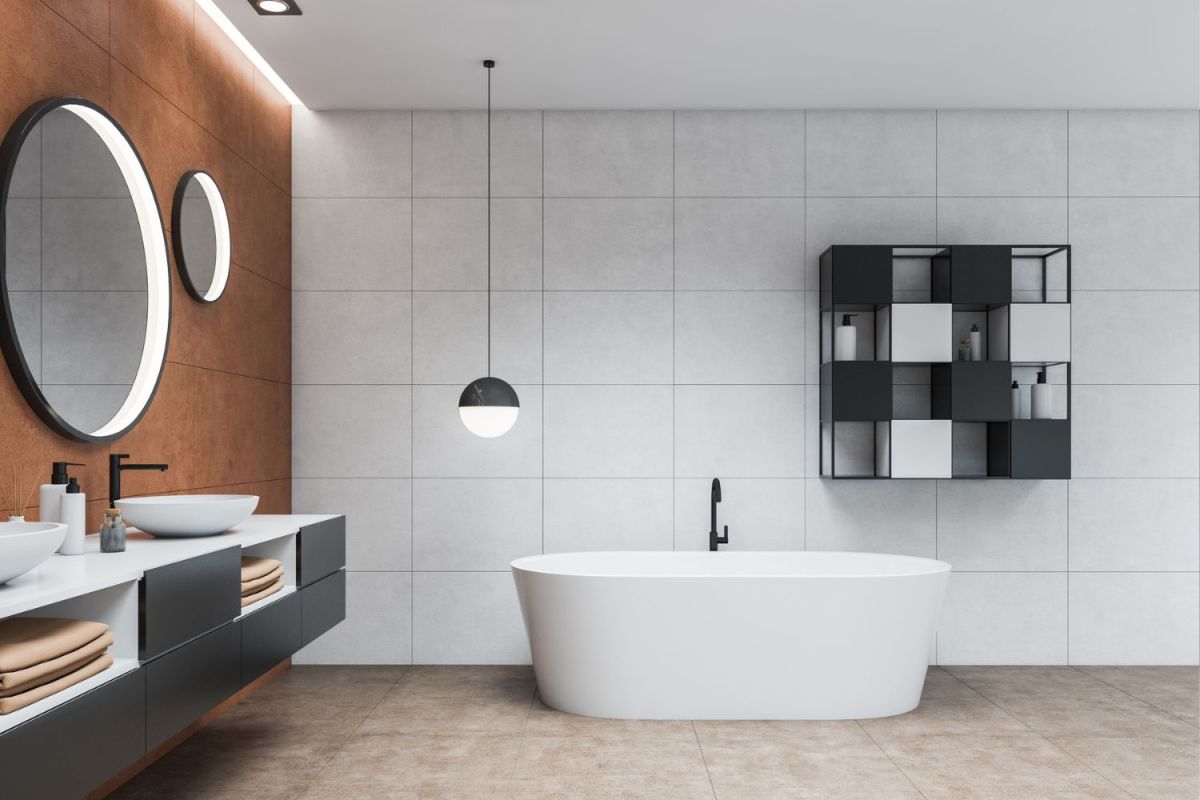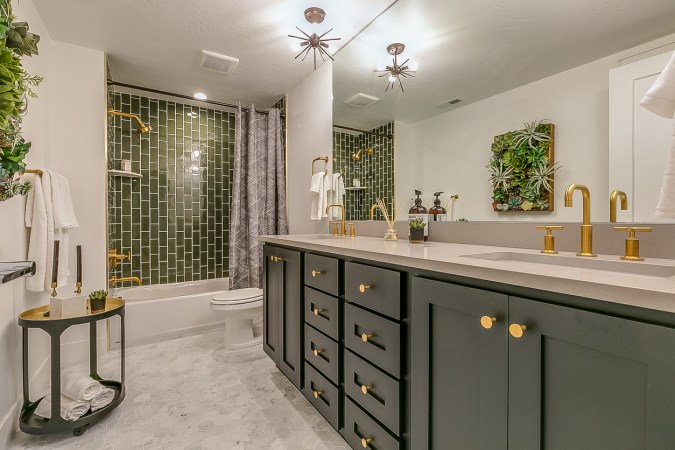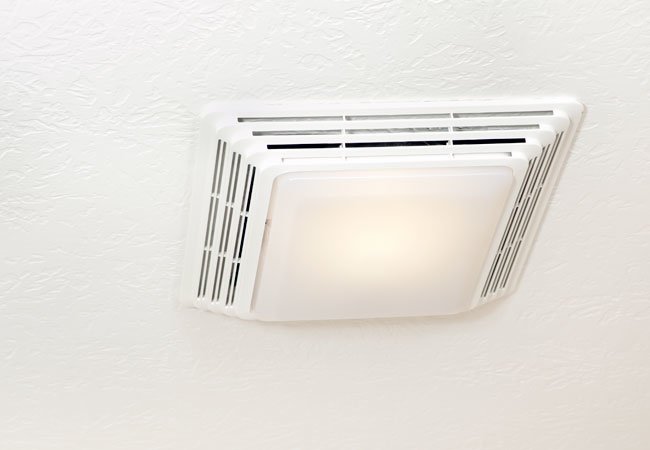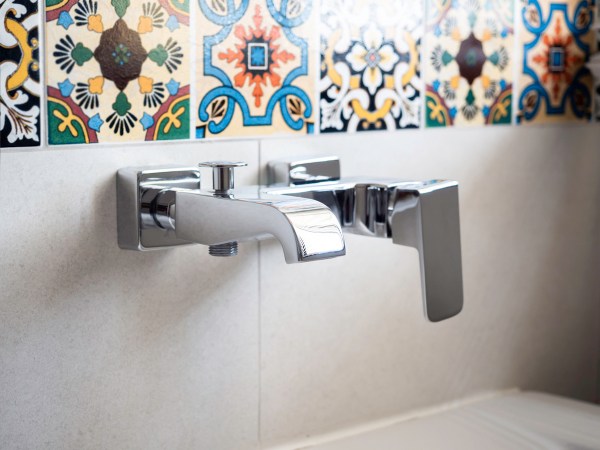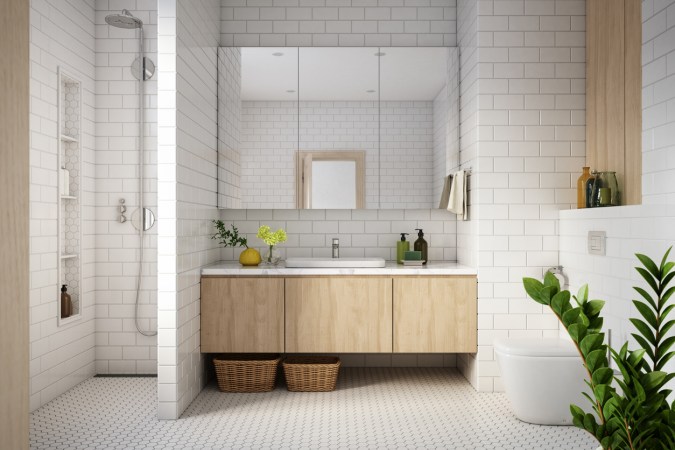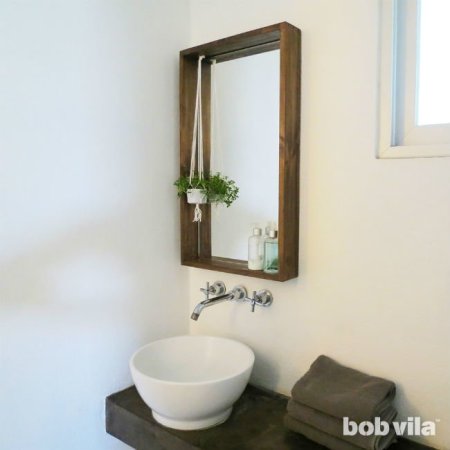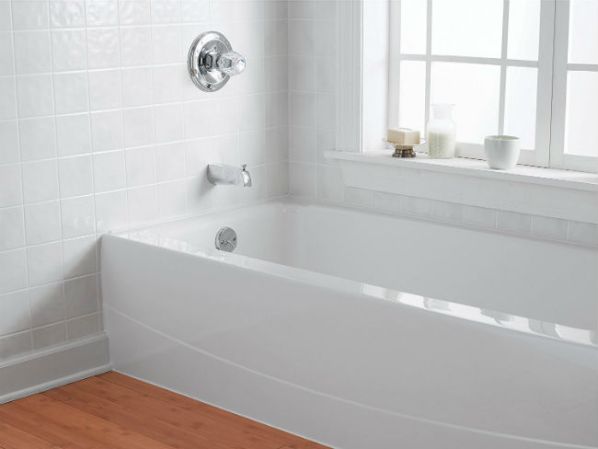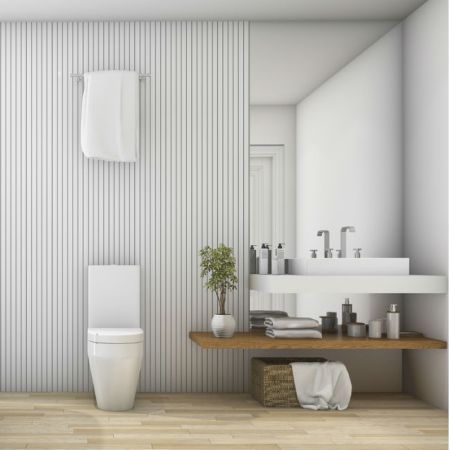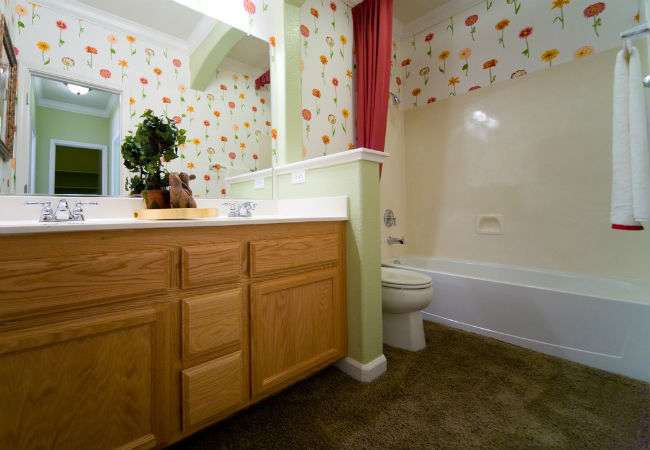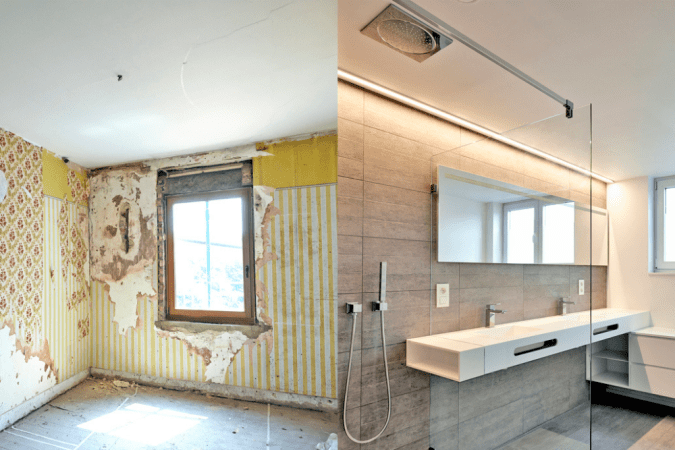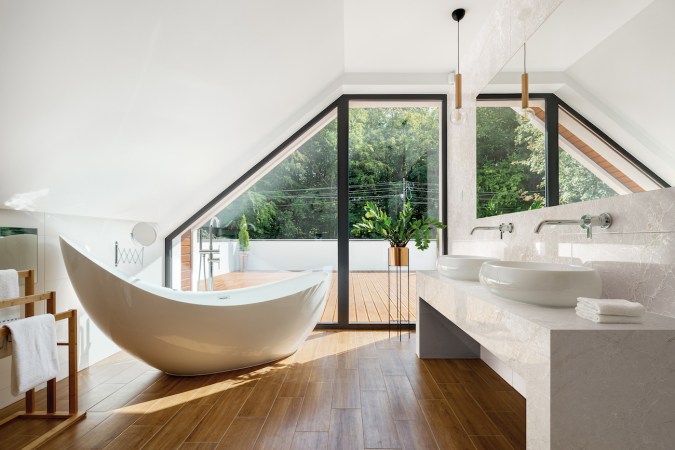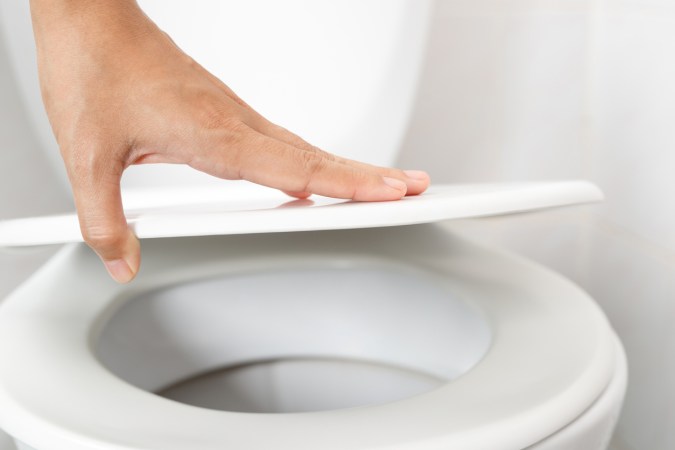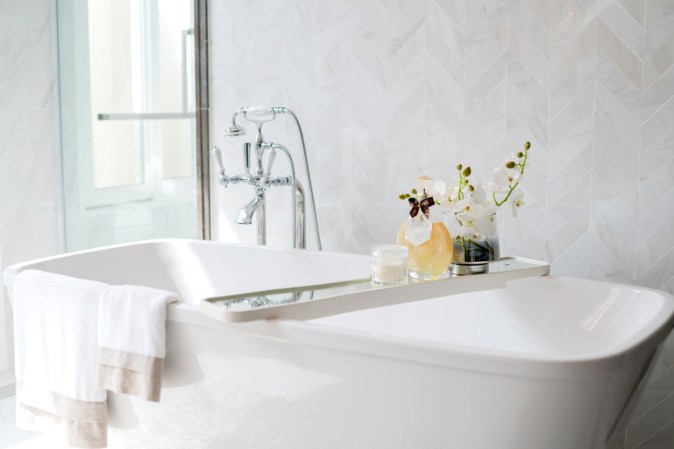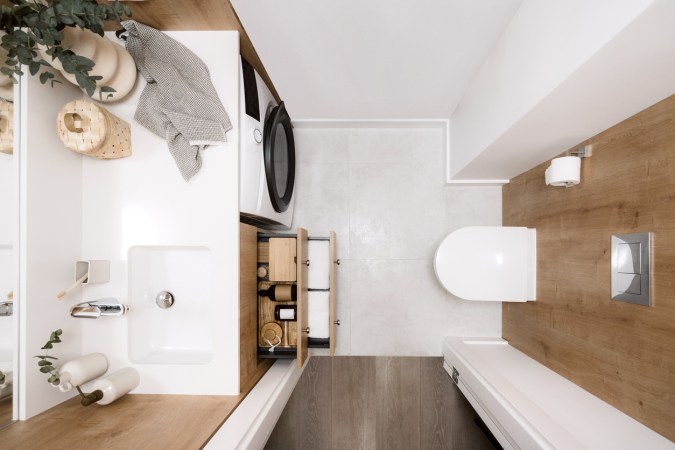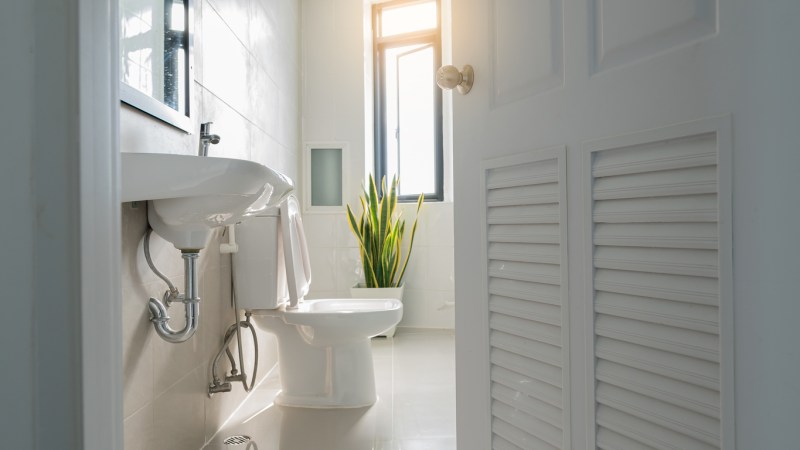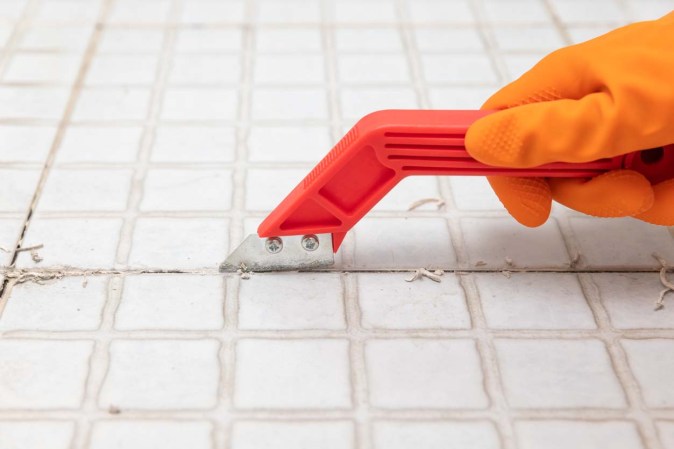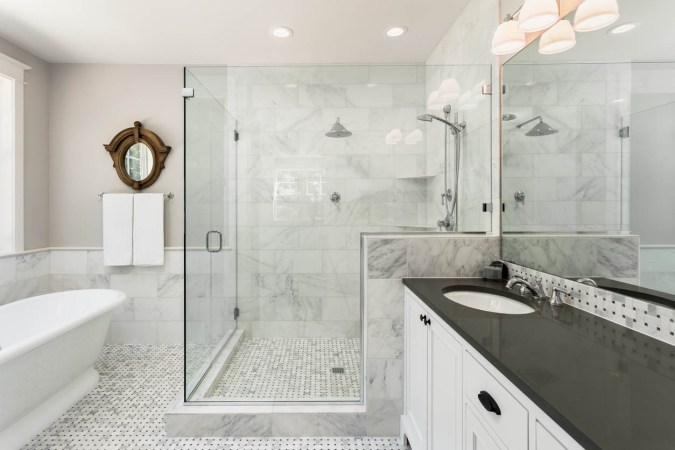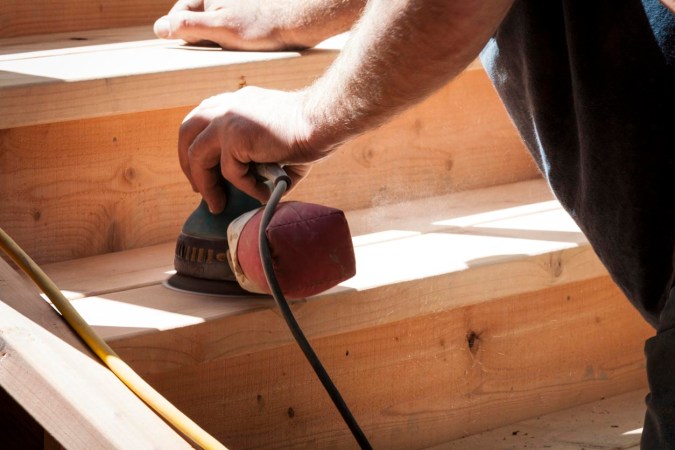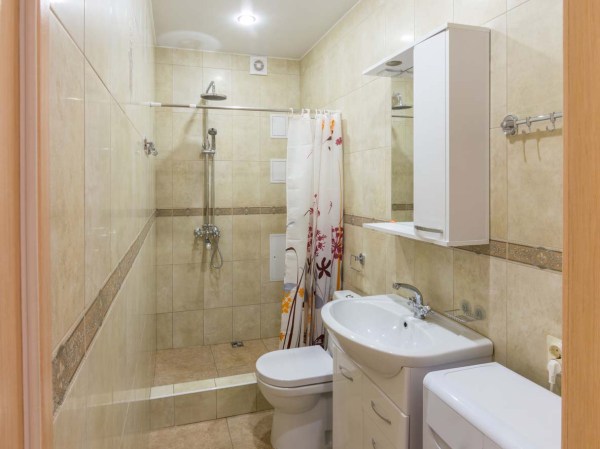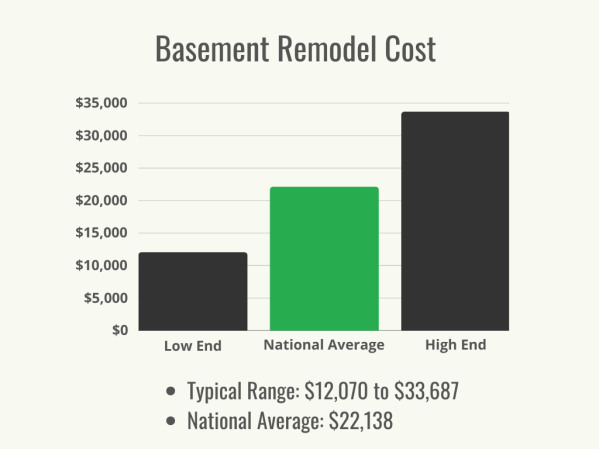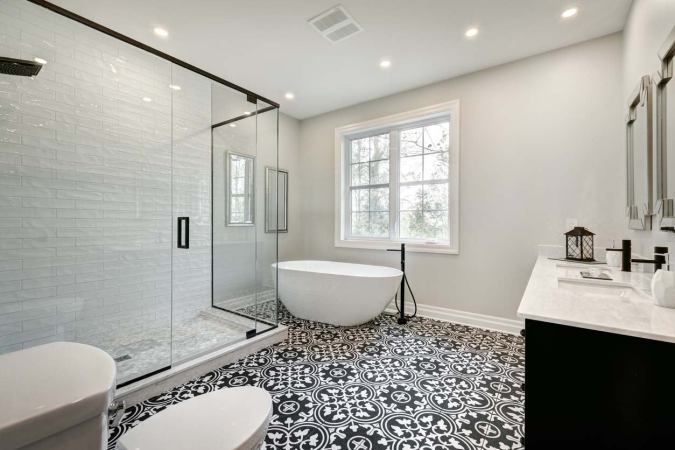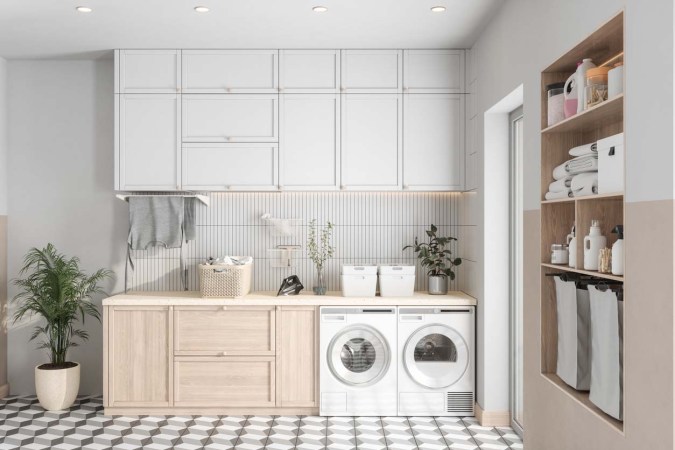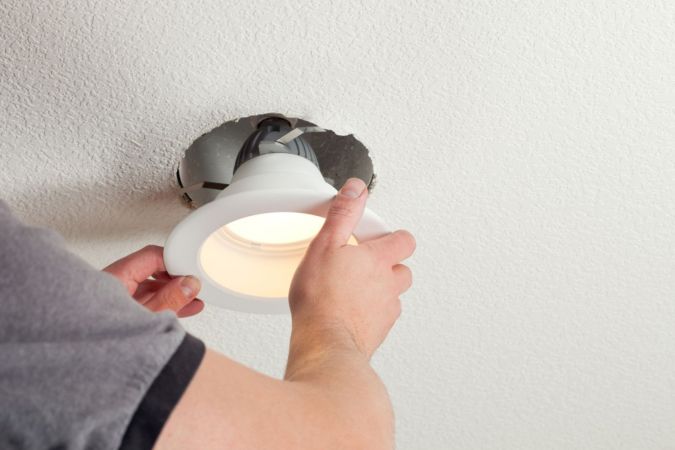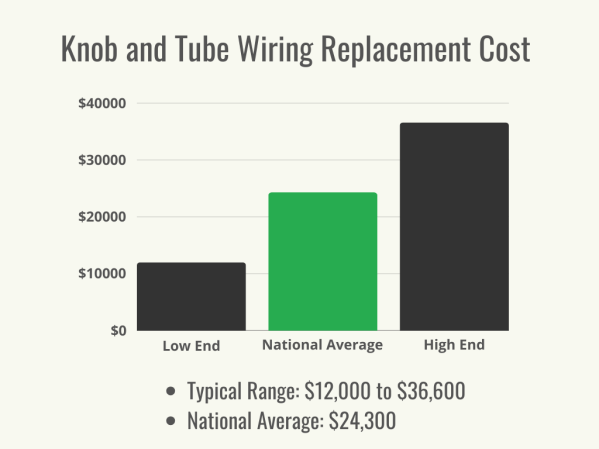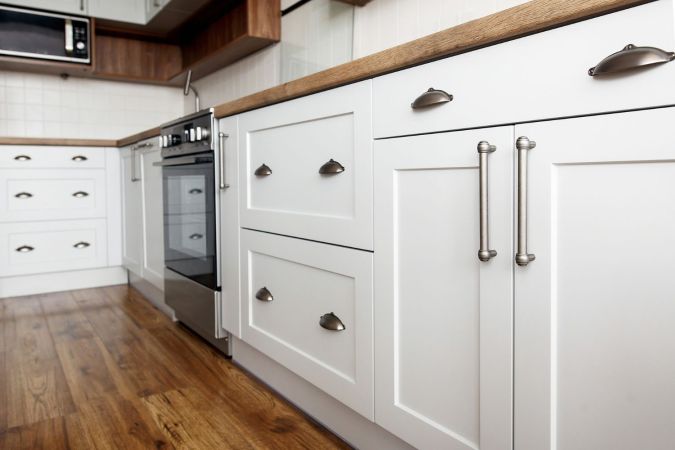We may earn revenue from the products available on this page and participate in affiliate programs. Learn More ›
Highlights
- The typical bathroom remodel in Washington, D.C., costs between $7,013 and $17,330, with an average of $12,033.
- There are several factors that affect the cost of a D.C. bathroom remodel, including the bathroom size and type, the building type, the fixtures and fittings, the project scope, and the cost of labor.
- The main benefits of remodeling a bathroom in D.C. include a high return on investment, improved safety, higher energy efficiency, better storage and functionality, and improved aesthetics.
- Some homeowners may be able to complete basic bathroom remodels themselves, but most will want to consider hiring a pro—especially if the remodel involves electrical or plumbing work.
From Alexandria, Virginia, to Silver Springs, Maryland, and everything in between, the greater Washington, D.C., area is filled with single-family homes, condos, and co-ops that are prime candidates for bathroom remodeling. Even if the home isn’t a colonial-era house that hasn’t been updated in decades, any home with bathrooms in disrepair or with out-of-date styles can be renewed with basic or high-end updates.
Undertaking a bathroom renovation could be as simple as updating paint, fixtures, and flooring, or it could be as complex as changing the layout, upgrading the plumbing, and installing high-end fixtures for a luxurious feel. The bigger the job, the higher the cost. So, how much does it cost to remodel a bathroom? According to HomeAdvisor, homeowners can expect to pay about $12,033 for an average bathroom remodel cost in D.C., though a typical range is $7,013 to $17,330. These bathroom remodeling costs tend to correlate with the higher cost of living in Washington, D.C., but even a basic bathroom upgrade can improve the vibe of one of the home’s most necessary rooms.
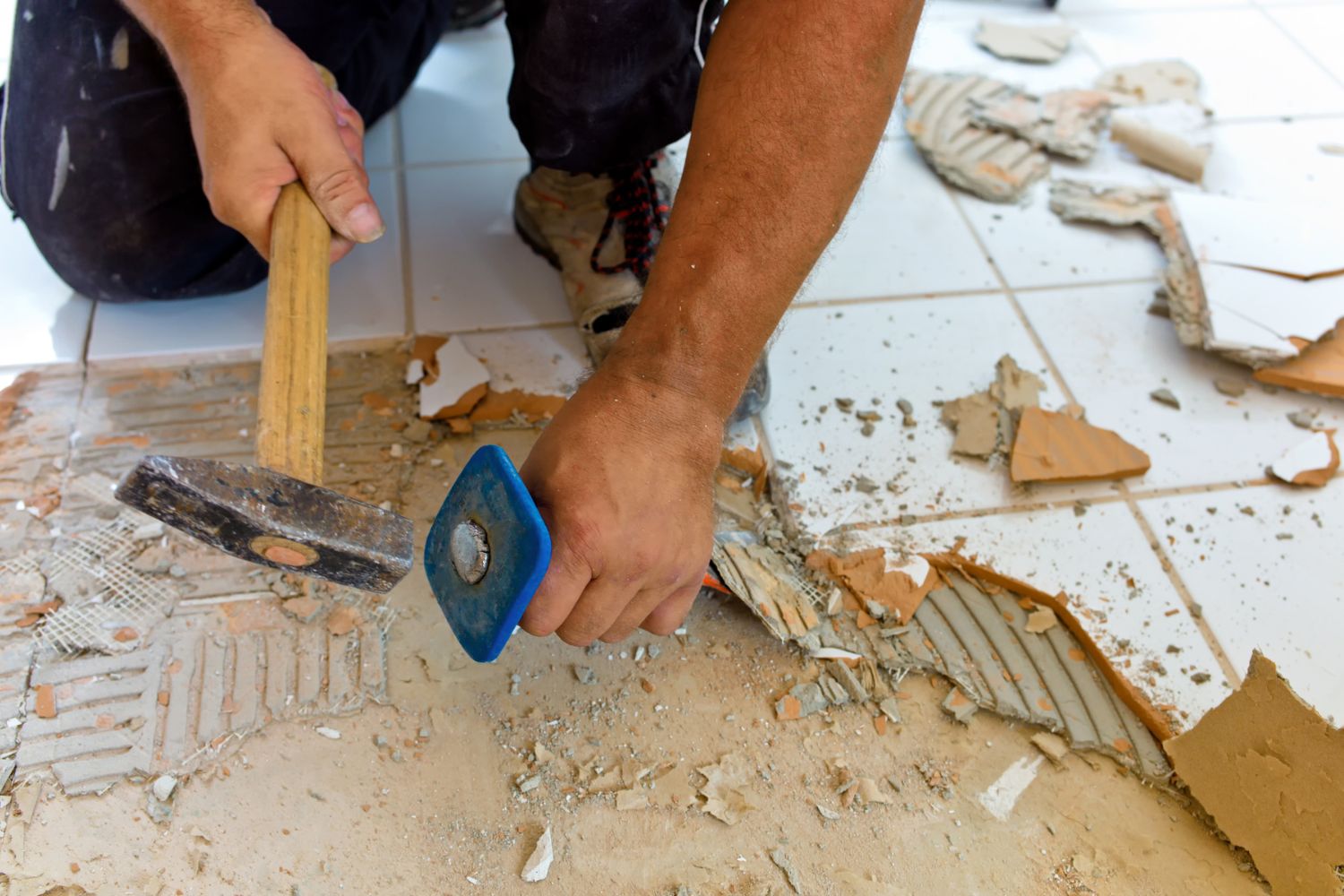
Factors in Calculating D.C. Bathroom Remodel Costs
A homeowner’s budget and immediate needs will be the primary drivers in determining the final cost of a bathroom remodel in D.C. Each project doesn’t have to transform a simple bathroom into a stunning primary bathroom worthy of a penthouse. Sometimes all that’s necessary is changing the vanity and adding some fresh paint and decor.
Primary Factors
Most homeowners can expect to plan for primary cost factors that include the bathroom size and type, the residence type, the types of fixtures and finishing materials, and the overall project scope. Labor rates and geographic location within the D.C. area will also play a role.
- Bathroom size and type. The size of the bathroom has some influence on the cost, since more materials are needed to update flooring in a larger bathroom than in a half bath. There are also many more fixtures that can be updated in a primary bathroom than in smaller bathrooms.
- Residence type. With a variety of residences in D.C., homeowners will see variations in cost depending on the type of building they live in. A private home is often much easier to renovate than a walk-up that’s difficult to access. There may be limitations on what homeowners can update if they live in a co-op building or own a condo that has restrictions from their homeowners association (HOA) or condo association.
- Fixtures and fittings. The type of fixtures a homeowner selects has a big impact on the bathroom remodeling cost. Replacing a big-box generic-brand bathroom faucet with a high-end luxury one can cost thousands of dollars. On the other end of the scale, some of the best bathroom light fixtures can cost under $100 each.
- Finishes. Another factor that can add up quickly while homeowners are remodeling a bathroom is the finishes. Budget bathroom remodels often use the cheaper product lines from brands like Delta, while high-end finishes can include tile from such companies as Ann Sacks and vanities by DXV.
- Project scope. If budget is a big consideration, homeowners will need to keep the project scope smaller if possible. Rerouting existing plumbing, changing the floor layout, and updating the subfloor are major cost considerations that may not apply to an apartment in D.C., but they might be necessary when homeowners are updating a historic home near Fairfax, Virginia.
- Labor costs. Urban areas have higher-than-average costs of living, and the greater Washington, D.C., area is no exception. Homeowners budgeting for the average cost of a bathroom remodel will see higher rates than in other areas around the country. On average, labor rates for bathroom remodels in D.C. average 25 percent to 35 percent of the total cost.
- Geographic location. Even within the greater D.C. area, there can be cost variations for bathroom remodeling projects due to accessibility issues, permitting, and other considerations. Construction projects in downtown D.C. neighborhoods such as Georgetown and Columbia Heights will come at a higher cost than in the more suburban areas such as New Carrollton, Maryland, and West Springfield, Virginia.
Secondary Factors
In some situations, secondary cost factors may apply to the homeowner’s project. These can include things like the current bathroom condition, repairs, decor, and any floor plan changes.
- Current bathroom condition. Some bathroom renovations start with a bigger task list than average. In this case, homeowners can expect to pay more for bathroom remodeling, since it’s likely that plumbing will need attention in addition to flooring, tile, and fixture upgrades.
- Water damage repair or mold remediation. A worst-case scenario for homeowners would include finding serious water damage or mold infestation. Private residences can more easily address these issues, but if a resident in a downtown D.C. condo experiences water damage due to another condo above them, the scope of work can significantly increase.
- Paint and decor. Homeowners with flexible budgets can spend quite a bit of money on new paint, wallpaper, or decor. The cost to paint a room, specifically a bathroom, averages $150 to $350, though a large primary bathroom can cost much more.
- Floor plan changes. Changing the floor plan of a bathroom is a massive undertaking that will greatly increase the bathroom remodeling cost. Residents living in a studio apartment in Adams Morgan, for example, likely won’t have the option to change their bathroom layout, but homeowners with single-family homes or other private residences may have the option to make the bathroom space more usable.
- Permits. Most renovation projects that involve updating electrical wiring or plumbing will require a permit. Simpler paint and fixture updates don’t typically require one. The local building department can help clarify if a permit is needed.
- Accessibility updates. In some cases, a bathroom needs renovating to make it more accessible for those with limited mobility. The layout can often remain the same; however, new fixtures, vanities, and showers may need to be installed to accommodate residents. Accessible bathrooms in private residences come at a different cost, so homeowners will want to speak with a contractor who is experienced in adhering to any Americans with Disabilities Act (ADA) compliance requirements.
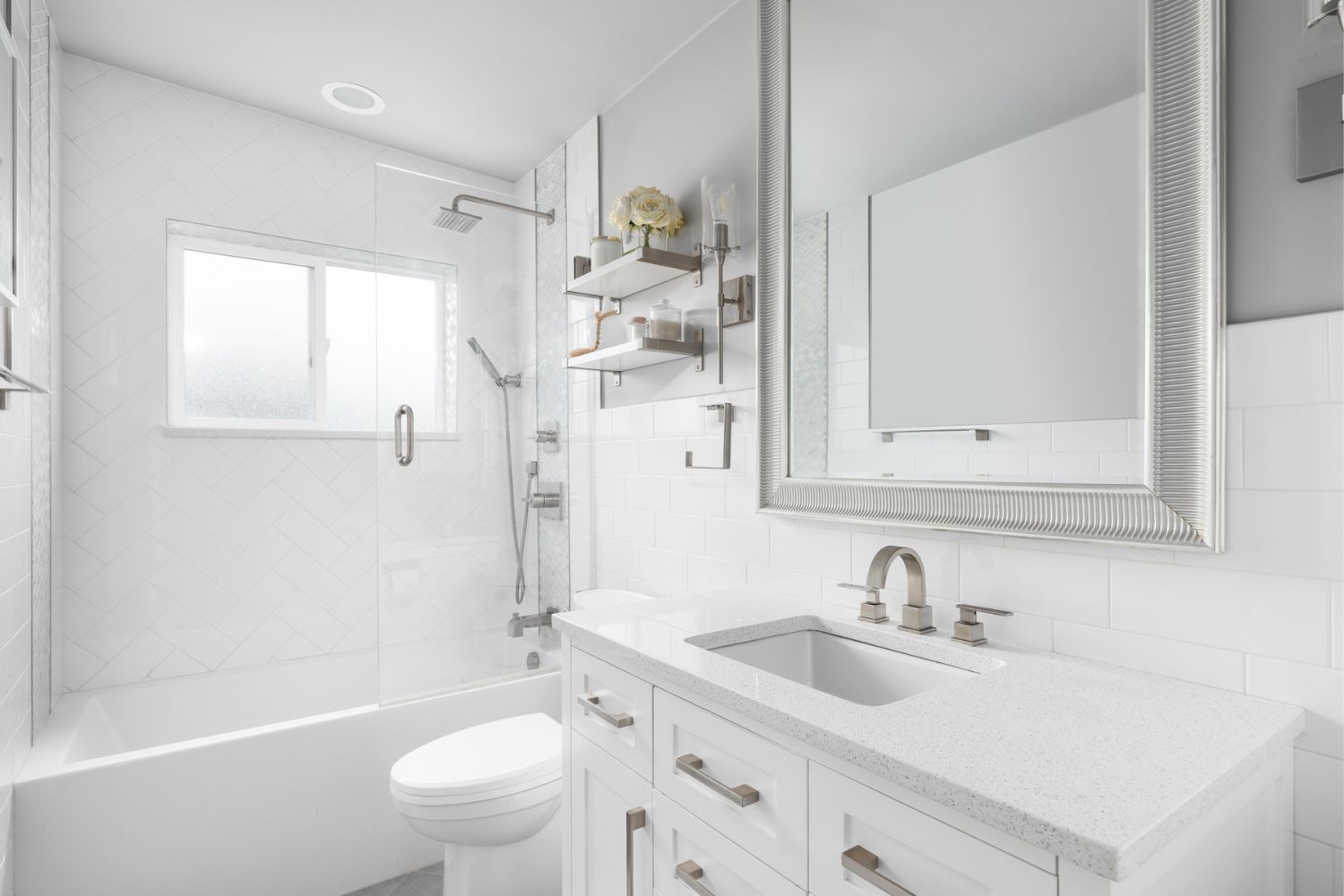
Types of Bathroom Remodels in D.C.
The definition of a bathroom can be a bit loose, since there are many types of bathrooms built for different purposes. From full bathrooms to powder rooms, bathrooms come in all sizes and styles, which means the cost of bathroom remodeling in D.C. will also vary depending on the type of bathroom.
- Full bathrooms. To qualify as a full bathroom, the room must have a sink, toilet, and shower or bathtub (or a combination shower and bathtub). The average bathroom remodel cost in D.C. of $12,033 will cover a full bathroom renovation without a lot of high-end upgrades.
- Guest bathrooms. A guest bathroom includes a sink, toilet, and shower or bathtub, which means remodeling costs will depend on the number of fixtures being replaced.
- Half bath or powder room. A handy option near an entry point, a half bath or powder room can be tucked into a tiny space and offer quick access for guests and family members. Half baths are common in suburban single-family homes and condos in downtown D.C.
- High-end bathroom. Most homeowners prefer to have the most luxurious bathroom in or near the primary bedroom. Remodeling a high-end bathroom will cost more than average, especially if homeowners are upgrading a full bathroom.
- Jack-and-Jill bathroom. This type of bathroom is located between two bedrooms with direct access to both. Changing an existing bathroom to a Jack-and-Jill bathroom can be costly, with the price depending entirely on the home’s layout. However, if an existing Jack-and-Jill bathroom needs to be refreshed, then renovating it will cost a little more than a full bathroom.
- Mobile home bathrooms. The total square footage of bathrooms in a mobile home is less than the square footage of the average bathroom in a traditional home. That means homeowners will pay less for a small-bathroom remodel.
- Primary bathroom. The main bedroom usually has a bathroom located nearby, which makes it the most heavily used bathroom in the home. Single-family homes with primary bathrooms usually have two vanities and a larger footprint, so they will cost more than average to renovate.
- Small bathroom. In between a half bath and a full bath, a small bathroom is another common option in condos around D.C. and the rest of the nation. A small-bathroom remodel costs less than a full bath remodel but more than a half-bath remodel.
- Wet room. A wet room has no separation between the shower and the bathroom floor. Wet rooms are great options for small bathrooms or for more accessible bathrooms in D.C. and surrounding cities. The drawback is the higher cost, since more waterproof materials are needed than normal to accommodate the open shower layout.
The Benefits of Getting a Bathroom Remodel in D.C.
As much as having a remodeled kitchen is becoming a necessity when homeowners are selling a home, having updated bathrooms is fast becoming just as necessary. Homeowners in the D.C. area often find they’ll have an increased home value, better energy efficiency, improved aesthetics, and other benefits if they choose to remodel their bathroom.
- Return on investment (ROI) and increased home value. Minimal updates won’t see as big of a return on investment. However, when a homeowner chooses to improve the layout, update the fixtures, or modernize the style, they can regain an average of 71 percent of the cost, according to the National Association of REALTORS.
- Improved safety. Many homes in the greater D.C. area are older than average, which means they might have outdated electrical systems or worn-out plumbing. A big advantage of a bathroom remodel in D.C. is that it can repair and update various fixtures, plumbing, and electrical systems that need attention. This ensures the safety of those using the bathroom and helps prevent leaks from broken pipes.
- Better energy efficiency. Older toilet models tend to use high volumes of water, which can be wasteful. Upgrading to water-efficient toilets that get the job done with less water usage can help homeowners live more sustainably. Additionally, outdated light fixtures can be more expensive to run; updated lights that are more energy-efficient can reduce energy consumption and costs.
- Enhanced functionality. Some bathroom layouts just don’t make sense. Rather than being located in the space wisely, fixtures are crammed into unlikely corners with little thought about daily use and comfort. Homeowners can achieve a higher level of satisfaction and functionality if they work with a bathroom remodeler in D.C. to design a more functional bathroom that feels pleasant to be in.
- Improved aesthetics/modernized design. One of the most common reasons people choose to remodel a bathroom is to improve the overall design. A bubble bath in a cozy or modern bathroom with fresh paint and decor is much more appealing than in a room with outdated wall tiles and mismatched design elements. The other main benefit is that an appealing bathroom with a more modern design will attract the attention of prospective buyers and result in a better ROI.
- Mold and mildew removal. Mold can be dangerous and difficult to properly detect. In most cases, professionally removing the contaminated materials is the safest way to avoid releasing mycotoxins into the air. Many small bathrooms in the D.C. area don’t have adequate ventilation, which makes them prone to mold and mildew in the humid environment.
- Storage expansion. Cabinets might not be the first thought when homeowners contemplate their D.C. bathroom remodeling project. Still, local designers know that space can be a premium in downtown D.C., which means it’s worth a discussion about adding bathroom cabinets during a remodel.
Bathroom remodeling costs in D.C. may seem like a huge investment that isn’t worth the hassle. Yet there are times when it’s necessary to take on such costs, such as when the plumbing is wearing out or there is significant mold and mildew. In these cases, the health and safety of the home’s occupants rely on a bathroom update. Also, homeowners looking to increase their home value prior to selling may receive better offers if they’ve invested in a quality bathroom remodel.
DIY vs. Hiring a Professional for a Bathroom Remodel in D.C.
With the right tools, painting a bathroom or changing flooring can be done relatively quickly and easily by a homeowner. However, if a bathroom remodel needs to include updating sinks, toilets, or bathtubs or changing the layout at all, then it’s best to call a pro. Any time electrical wiring or plumbing is involved, an inexperienced DIYer may cause a more complicated problem and safety issues while trying to update a light fixture or a shower faucet.
Professional bathroom remodeling companies in the D.C. area, like all pro installers, are careful to avoid causing unnecessary damage during any demolition tasks. They’re also qualified and skilled at repairing plumbing and electrical issues that may arise (both expected and unexpected) during the project. Additionally, professional bathroom remodelers have design experience and can work with the homeowner to plan the ideal update that suits the desired aesthetic. Pro installers also have the trucks to deliver materials into downtown D.C., where many homeowners may not even have a vehicle. It’s much easier to let the contractors handle navigating traffic and parking on the narrow streets of D.C. neighborhoods.
The Best Bathroom Remodeling Companies in D.C.
Since labor makes up a large portion of bathroom remodeling costs, it’s natural for homeowners to wonder whether they should DIY a bathroom remodel or hire a pro. Ultimately, homeowners find that hiring one of the best bathroom remodeling companies ensures a quality result that will improve the home’s value.
Opting for a local, D.C.-headquartered bathroom remodeling company comes with several benefits. First, these companies are intimately familiar with the area and know the different codes and requirements. They may also have connections with local companies, enabling them to source fixtures and fittings. The following are a few options to consider.
- Four Brothers Design + Build is an award-winning home remodeling company in the greater D.C. area (including Maryland and northern Virginia). With 15 years of architecture, design, and contracting experience, Four Brothers offers clients a combination design and build process for a custom project for the bathroom or entire home.
- Dupont Design Center has offered home remodeling services in Washington, D.C., for 10 years and specializes in bathroom and kitchen renovations. The company provides a free 3D design rendering for homeowners to envision what the remodel could look like before booking its in-demand services. In a high-cost city, the appeal of budget remodeling that doesn’t skimp on quality can’t be beat.
- Zen Renovations is a top-rated, local remodeling company that has served the Maryland and Washington, D.C., area for 30 years. The team is composed of craftsmen, architects, designers, and installers who help homeowners bring their home remodeling dreams to life from conception to actualization. Additionally, the company offers a 5-year warranty on its work.
Alternatively, homeowners may prefer to work with well-known national companies for their bathroom remodeling project. These companies have the benefit of a well-known reputation and decades of experience. Two such options include the following.
- The Home Depot offers homeowners an all-in-one place to find the fixtures they like—and at prices that meet most budgets. DIYers can find paint and sink faucets to install themselves, or they can choose a bathtub, tile, or flooring for a contractor to install.
- Angi is an ideal website for a homeowner to search for the right bathroom remodeler in their area. With dozens of potential companies to choose from, finding the right contractor is easy. And each pro is rated by locals who previously hired them, which means homeowners can trust that they’re vetted and qualified.
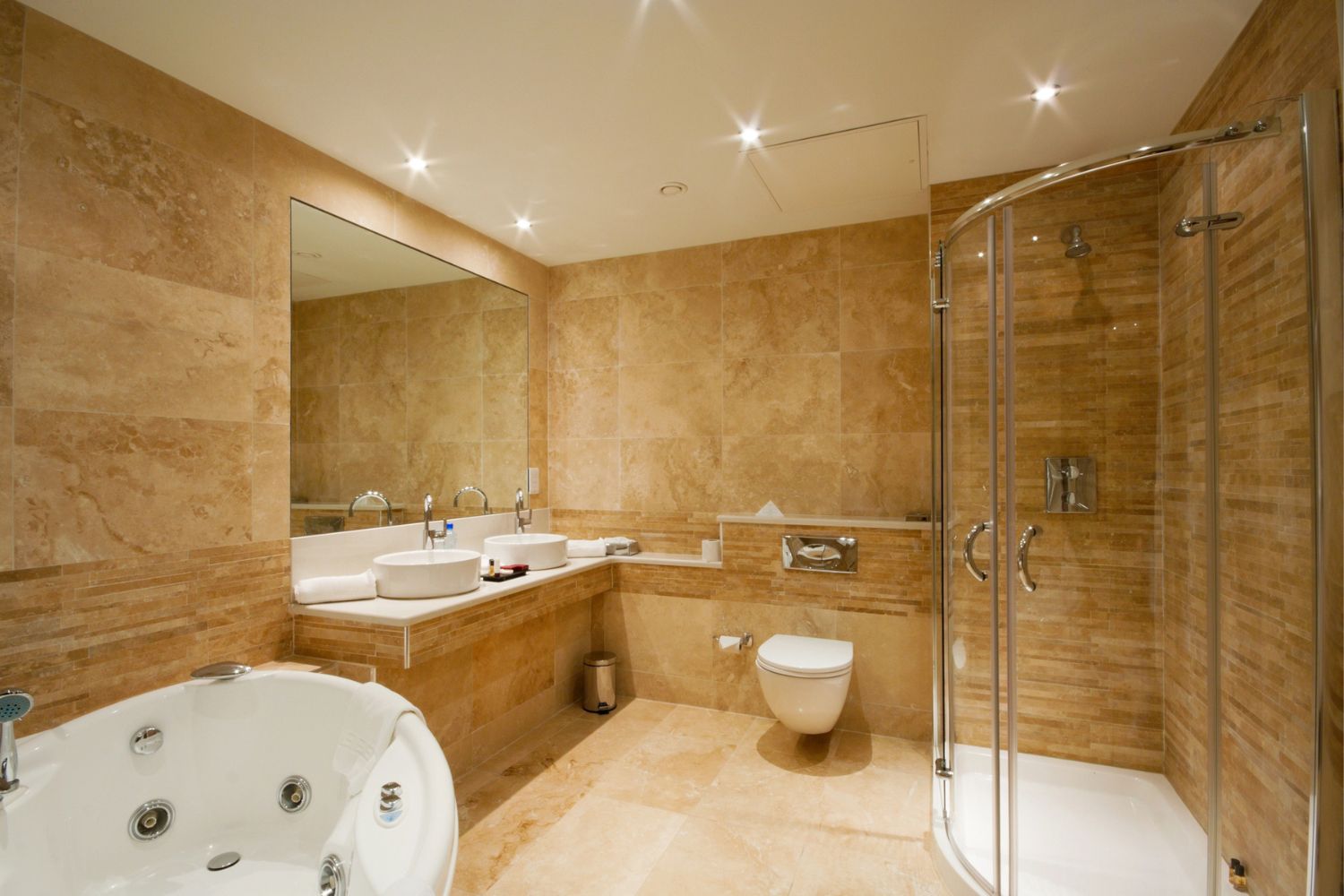
How to Save on and Pay for a Bathroom Remodel in D.C.
Even a budget bathroom remodel comes with a price tag, so it’s natural for homeowners to look for ways to save money. There are also many options available to homeowners curious about paying for a remodel.
How to Save
Asking for multiple quotes and opting for traditional fixtures are great starting points for reducing the final bill, but there are several other ways homeowners can reduce the remodeling cost.
- Ask about remnant materials. Granite shops, paint stores, and flooring companies often have remnants or partial orders available for a discounted price. While a discounted remnant piece of granite might not work for a double vanity, it could be the perfect size for a half-bath vanity.
- Compare fixture prices. If budget is the main driver for choosing new fixtures, homeowners may want to get quotes from multiple remodeling companies and compare them against local hardware store prices. Sometimes it’s a little cheaper to purchase fixtures on sale directly from a local store and have the contractor install them.
- Obtain multiple quotes. Contractors may have different rates for remodeling jobs, and they’ll have different value propositions that can affect the final price.
- DIY prep or finish work. Homeowners who have the time and experience may be able to save on labor costs by removing old fixtures and flooring or doing the final painting and decorating tasks.
- Plan the basic design ahead of time. Many remodeling companies offer design services in addition to installation, but they can sometimes come at an additional cost. This step probably can’t be skipped if the bathroom layout is being changed, but if a homeowner is seeking to simply modernize and upgrade fixtures, they can create their own design plan.
How to Pay
Obtaining financing and taking out loans are the most common ways to pay for home renovation projects when funds aren’t immediately available.
- Tap into savings. Some homeowners have extra funds set aside for home improvement projects, which makes it easier to plan and stick to a budget.
- Borrow from friends or family. In some cases, homeowners may be able to borrow additional funds from people they know well who can offer interest-free or low-interest loans.
- Consider contractor financing. Many remodeling contractors have been in business long enough that they can offer competitive rates for homeowners who want to finance their project directly with the contractor.
- Obtain a home improvement loan. Many of the best home improvement loans offer homeowners any easy way to complete renovations that will increase their home’s value.
- Ask about a home equity loan. Some D.C. homeowners may prefer to choose one of the best home equity loans, such as through U.S. Bank or Flagstar Bank, to finance their bathroom remodeling project.
- Research local programs. The District of Columbia has local programs (such as those available through Veterans Affairs, Habitat for Humanity, and Department of Housing and Community Development) that can assist qualifying homeowners with certain home improvement projects.
- Look into senior citizen programs. Washington, D.C., has two programs for seniors who need assistance with repairs and maintenance, the Senior Citizens’ Home Repair and Improvement Program, and Senior Citizens’ Home Repair Program.
Questions to Ask About Bathroom Remodeling in D.C.
Knowing who to hire for a bathroom remodel is an important first step for homeowners planning this project. That’s why it’s always a good idea for them to ask lots of questions during the vetting process.
- Are you licensed, bonded, and insured?
- How long have you worked in the greater D.C. area?
- Is my city included in your service locations?
- What types of services do you provide?
- Who will make the design decisions?
- Do you offer free estimates on site?
- Will my plumbing need to be updated?
- How much will it cost to change the layout of just one fixture, like my bathtub?
- How long will the project take once the designs are finalized?
- Can I buy my own fixtures and materials and have you install them?
- How much will I save if I remove all my existing cabinets, fixtures, and flooring?
- What permits will I need, and who will obtain them?
- What kind of financing do you offer?
- I live on a one-way street in downtown D.C. How will you handle the delivery of materials?
- Do you offer any warranties or guarantees?
- Do you subcontract any work?
- Who will be my point of contact during the project?
FAQs
The cost to remodel a bathroom in Washington, D.C., will be higher than in many other cities across the country, yet the project gives homeowners a professional-quality bathroom that improves their home’s value. Homeowners will want to work closely with a contractor to understand permits, hidden costs, and home value increases.
Q. Do you need a permit to renovate a bathroom in D.C.?
According to the D.C. Department of Building, a permit is required anytime a homeowner alters or renovates an existing space. This can even include some types of repairs. Local bathroom remodeling contractors in D.C. will be familiar with the type and cost of permits needed for each specific renovation project.
Q. What are the hidden costs of renovating a bathroom in Washington, D.C.?
No matter how well a bathroom is inspected prior to a contractual agreement, there is always the possibility of a serious problem lurking in the plumbing, HVAC, or electrical systems that can’t be detected until the walls or floors are removed. Unfortunately, these issues are also the most costly to repair—and the most necessary.
Q. How much value does a Virginia or D.C. bathroom remodel add?
The amount of returned value on a bathroom remodel in Virginia or D.C. will vary depending on the type of bathroom and the level of upgrades. The National Association of REALTORS estimates that a bathroom remodel has a 71 percent return on investment (ROI), though this figure is nationwide. While some D.C. contractors estimate a 54 percent ROI on a bathroom remodel, some homeowners may have only a 34 percent ROI if they spend a lot of money on high-end fixtures.
